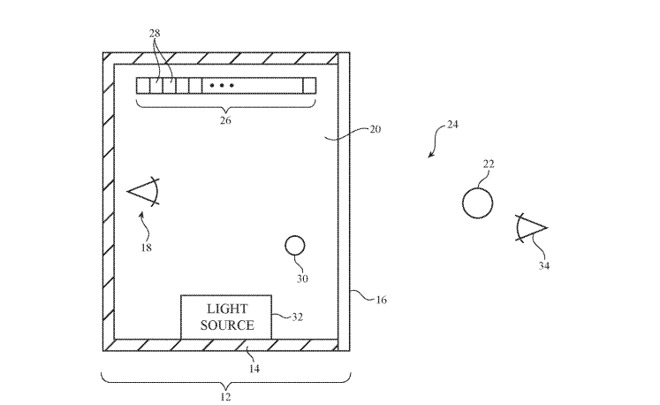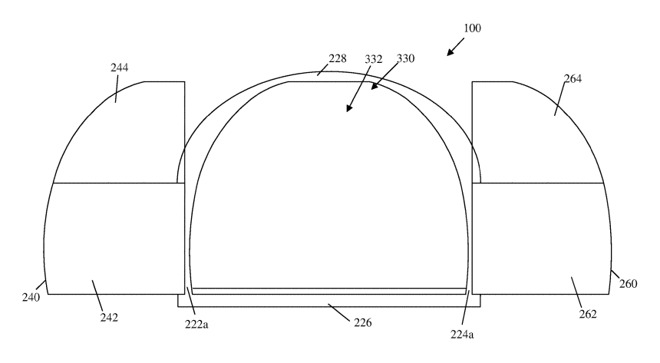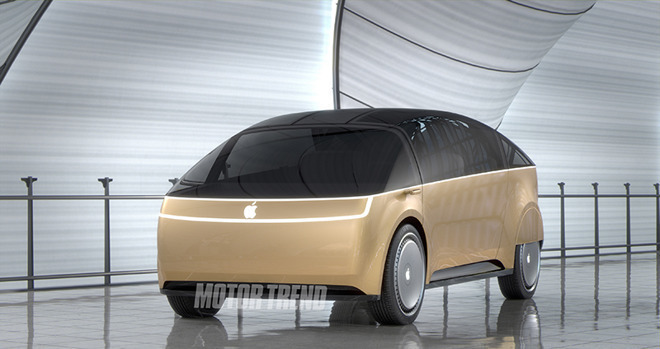Apple Car could have variable light control to protect privacy of riders, doors that open ...
Apple is working out ways its "Project Titan" self-driving vehicle could be improved to give its users more privacy via a band-based lighting system, as well as a door system that can provide far greater access to the inside of the car than how current doors can open.
Doors are an important element in the design of a car, as they not only are functional in allowing people in and out of a vehicle, but they can also inform the styling. Car doors have evolved from a simple swinging hinge to "gull wing" doors, sliding doors, and even "suicide doors" where the hinge is to the rear instead of the front, with each giving a different distinct aesthetic when opened.
Along with the doors, a less obvious design choice involves glass, as while most people elect to have clear windows, some who prefer to protect their privacy may want to opt for tinted versions. While they do provide some privacy, they do not offer much when the vehicle cabin is illuminated, nor can it be disabled to provide a clearer view to the inside for passers by.
In a pair of patents granted to Apple by the US Patent and Trademark Office on Tuesday, Apple has ideas covering both areas, offering a solution to the tinting dilemma as well as an unusual door configuration.
The first patent, an "Interior lighting system having window with band pass filter coordinated with broad/narrow band light source to provide privacy mode," suggests Apple Cars internal lighting system may be able to control what can or cannot be seen by onlookers.
The glass would be treated with a light filter that is able to allow light to pass through without issue, when used with broad visible bands of light. The filter would however prevent specific narrow bands of light from passing through, so if only some blockable bands were used by the lighting system, it would seem as though no light would pass through to onlookers.

An example 'room' giving an idea of how a narrow band light source could illuminate the area privately just for passengers.
Apple's internal lighting system, made up of LEDs of different colors in order to control the light that is emitted, would be able to switch between two different light modes, covering the entire visible light spectrum and narrow bands. Switching between the two, users could select either to light the vehicle and allow everyone to see under the broad band mode, or to have light within the cabin but without passing through the windows in a private narrow band mode.
This would effectively give users the choice of tinting or non-tinting, without the downside of tinting failing to protect against internal illumination defeating the whole point of privacy.
Apple also suggests the use of a liquid crystal layer as a form of adjustable light filter. It explored the concept in another recent patent filing, one that would allow a light source in the TrueDepth camera array to switch between dot projecting and flood illumination modes.
Apple here is going for a somewhat modified "suicide" door appearance, with the front and rear having mechanisms at either end of the vehicle instead of at the front of both doors. The modified element is that instead of swinging open, both the front and back doors slide out of the way.
The mechanism, which can work without the central door pillar, means that the car could open up both doors to give an extremely wide and unencumbered entranceway into and out of the vehicle to passengers. If it were a self-driving vehicle, where seating positions could be freed up, this could give even more space to get into seats, with a clear section in the middle.

An illustration of how wide the doors could open according to Apple's patent filing.
Rater than just opening the door, the patent also brings up an extra element in the form of raising and lowering window sections. On opening and closing, the windows would lower to get past the top edge of the door's structure, then when closed, would raise back up into a cavity, and forming a seal.
This design would allow for an extremely tight seal to be created, as well as potentially pinning the door closed to eliminate the potential for opening while in transit.
Apple files numerous patents with the USPTO on a weekly basis, but while the existence of patents and filings are not a guarantee that they will appear in a future Apple product or service, they do indicate areas of interest for the company's research and development efforts.
"Project Titan" is the name used to cover Apple's self-driving and automotive efforts, including computer vision, sensors of various kinds, locomotion, and vehicular design. Initially thought to be about the design of an Apple-branded car, it was then pivoted to focus more on the self-driving system, which is currently being tested in California, but some elements of car design still surface from time to time.
As part of these design elements, Apple has attempted to rethink how sunroof systems work, including a fully customizable version and one that slides along tracks that are neither straight nor parallel.
It has also investigated the possibility of using smart seatbelts, point of interest capture systems, inter-car communications, and fiber optic systems, along with augmented reality navigation.
Doors are an important element in the design of a car, as they not only are functional in allowing people in and out of a vehicle, but they can also inform the styling. Car doors have evolved from a simple swinging hinge to "gull wing" doors, sliding doors, and even "suicide doors" where the hinge is to the rear instead of the front, with each giving a different distinct aesthetic when opened.
Along with the doors, a less obvious design choice involves glass, as while most people elect to have clear windows, some who prefer to protect their privacy may want to opt for tinted versions. While they do provide some privacy, they do not offer much when the vehicle cabin is illuminated, nor can it be disabled to provide a clearer view to the inside for passers by.
In a pair of patents granted to Apple by the US Patent and Trademark Office on Tuesday, Apple has ideas covering both areas, offering a solution to the tinting dilemma as well as an unusual door configuration.
Variable lighting to hide Apple Car occupants?
The first patent, an "Interior lighting system having window with band pass filter coordinated with broad/narrow band light source to provide privacy mode," suggests Apple Cars internal lighting system may be able to control what can or cannot be seen by onlookers.
The glass would be treated with a light filter that is able to allow light to pass through without issue, when used with broad visible bands of light. The filter would however prevent specific narrow bands of light from passing through, so if only some blockable bands were used by the lighting system, it would seem as though no light would pass through to onlookers.

An example 'room' giving an idea of how a narrow band light source could illuminate the area privately just for passengers.
Apple's internal lighting system, made up of LEDs of different colors in order to control the light that is emitted, would be able to switch between two different light modes, covering the entire visible light spectrum and narrow bands. Switching between the two, users could select either to light the vehicle and allow everyone to see under the broad band mode, or to have light within the cabin but without passing through the windows in a private narrow band mode.
This would effectively give users the choice of tinting or non-tinting, without the downside of tinting failing to protect against internal illumination defeating the whole point of privacy.
Apple also suggests the use of a liquid crystal layer as a form of adjustable light filter. It explored the concept in another recent patent filing, one that would allow a light source in the TrueDepth camera array to switch between dot projecting and flood illumination modes.
Apple Car with suicide doors?
The second patent, "Passenger vehicle door and window" explains how the front and rear passenger doors of an Apple Car could open up.Apple here is going for a somewhat modified "suicide" door appearance, with the front and rear having mechanisms at either end of the vehicle instead of at the front of both doors. The modified element is that instead of swinging open, both the front and back doors slide out of the way.
The mechanism, which can work without the central door pillar, means that the car could open up both doors to give an extremely wide and unencumbered entranceway into and out of the vehicle to passengers. If it were a self-driving vehicle, where seating positions could be freed up, this could give even more space to get into seats, with a clear section in the middle.

An illustration of how wide the doors could open according to Apple's patent filing.
Rater than just opening the door, the patent also brings up an extra element in the form of raising and lowering window sections. On opening and closing, the windows would lower to get past the top edge of the door's structure, then when closed, would raise back up into a cavity, and forming a seal.
This design would allow for an extremely tight seal to be created, as well as potentially pinning the door closed to eliminate the potential for opening while in transit.
Apple files numerous patents with the USPTO on a weekly basis, but while the existence of patents and filings are not a guarantee that they will appear in a future Apple product or service, they do indicate areas of interest for the company's research and development efforts.
"Project Titan" is the name used to cover Apple's self-driving and automotive efforts, including computer vision, sensors of various kinds, locomotion, and vehicular design. Initially thought to be about the design of an Apple-branded car, it was then pivoted to focus more on the self-driving system, which is currently being tested in California, but some elements of car design still surface from time to time.
As part of these design elements, Apple has attempted to rethink how sunroof systems work, including a fully customizable version and one that slides along tracks that are neither straight nor parallel.
It has also investigated the possibility of using smart seatbelts, point of interest capture systems, inter-car communications, and fiber optic systems, along with augmented reality navigation.


Comments
Apple either needs to find product market fit in transportation or move on. The R&D spend level is through the roof and nothing is coming out of the other end. In the last ten years, Apple has launched Apple Watch, Airpods and bunch of services. There does not seem to be any sense of urgency in Tim Cook's world
This week Elon Musk put it well:
"If you don't buy a Tesla, in three years it will feel like you're driving a horse".
(My apologies for any butchering of his quote).
While his time frame may be debatable, his prediction is not: Cars of the future are likely to be as different from cars of tomorrow as an Apple II is from an MacBook Pro or an iPhone.
And, he explained his prediction further when he said: Roads will be shared by manually driven vehicles as well as self-driving vehicles -- just as they were shared by horses and horseless carriages 100 years ago.
My point is that R&D spending has gone stratospheric ($16B/yr) and there is little to shown for it. I do not have a breakout for Titan but I believe it is a material component. The cost structure of the company has gone sideways (gross margins, operating margins, SGA $, R&D $)
Bottom line - either you have faith or you don't in Apple's ability to enter and dominant new markets. I'm increasingly concerned Apple is slowing down. It has been 9+ years since the iPad
Like the others here, I think you’ve got your own reality distortion field going strong.
Aside from Project Titan, Apple Watch, EarPods, and other things that have already been mentioned, Apple has hired a boatload of scientists and medical doctors to study and hopefully develop breakthrough devices that can fundamentally change personal healthcare. Those people are expensive as are their science projects. No one can be sure what will emerge over the next few years. But what is embedded in Apple’s DNA makes me believe they may solve a few problems that the medical industry has not fully put its time, money and will into solving.
The first iPhone was birthed by a small, very tight group of highly capable people who collaborated like crazy. I don't equate spending large amounts of money like a drunk sailor with being innovative. Large teams have never historically been in Apple's DNA
How is it even possible to spend $4B/quarter in R&D? At this point, grab some popcorn and see how it all plays out
Back in the 1960s, TV sitcoms written by guys born before the 1920s were always doing episodes with zany long-haired "rock band" characters turning up for some crazy caper, while the show's regular characters awkwardly try to keep up and "be cool." The "rock band" guys were always these supremely not cool superficial representations of what the 50-plus-year-old writers thought the youth culture was all about, but were grievously and totally wrong. That picture of the "Apple Car" is a zany long-haired 1960s sitcom "rock band" character.
It's completely terrible.
The windows on my wife's Cooper MINI does exactly that. Presumably Apple's approach is different somehow.
2. There is zero evidence of Apple building — or even getting permits for — facilities that could manufacture a car. If a factory permit application turned up tomorrow, it would be a minimum of 10 years before it was producing cars.
3. There is, however, lots of evidence that Apple is building and researching car systems. Perhaps that will be used to augment a forthcoming car from an existing manufacturer, or the tech will be offered to the industry as a whole a la CarPlay, or Apple could partner with a manufacturer to produce a car in a partnership.
To me, the last option seems — by far — the most likely set of scenarios. So far, a majority of the little we actually know about “Project Titan” is that Apple has been focused on mapping/navigation, and safety regarding vehicles with at least some level of self-driving capability. Despite the lead of the story making reference to an “Apple Car,” further down the article makes clear that the program — if it was ever trying to build its own car for anything other than prototyping purposes — pivoted to other aims quite some time back.
To put this another way: if Apple was building a car to debut next year or the year after — there’d be no way a prototype would not have been spotted being road tested by now. The amount of licensing and permitting to do something like that takes ages — the fact that one hasn’t been seen suggests no possibility of it happening within the next two years at a minimum.